Matador Network's Blog, page 739
December 1, 2020
New Zealand Forest of Hope
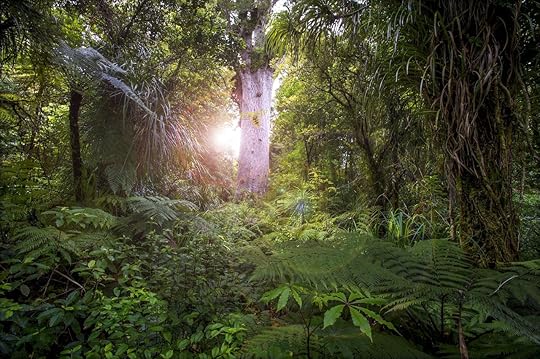
To say 2020 has been full of disappointments is to put the profound upset of this year mildly. Sure, there is still plenty to be grateful for, but it’s safe to say that most people are ready to put this entire year behind them and look toward the future. And while pandemics and politics don’t necessarily recognize the dividing line of a new year, 2021 still has the capacity to offer the hope we need to get through this uniquely terrible time in history.
New Zealand, as the first country on the planet to kick off 2021, has a plan to set those good vibes in motion. No, it won’t be opening its borders anytime soon, but until that happens, anyone with disappointment to cast out and positivity to call in can participate in growing its Forest of Hope.
Whether you missed out on a milestone birthday, had to cancel a wedding, or even postpone a bucket list vacation, your 2020 woes can now be turned into an actual tree. Every disappointment from this year shared on New Zealand’s website will be converted into the planting of a tree in the country, ultimately turning into an entire new forest of native trees born of disappointment but grown with hope.
And instead of complaining to loved ones about the ways in which 2020 has been terrible, there is the option to gift a tree to them through New Zealand’s gift registry via Trees That Count. For $7 you can write a message and then follow the tree on its journey when it is planted in New Zealand. With socially distant holidays being a reality this year, a tree can be a delightful gift from afar.
In a year that’s made so many feel so helpless, converting that negative energy into a planted tree is a true act of positivity. Trees are the planet’s first line of defense against climate change, taking in CO2 from the air and turning it into oxygen (and they absorb plenty of other toxins as well). Plus, their roots keep the soil together amid heavy rains and rampaging fires, while wildlife counts on them for shelter.
Trees are good for people, too. Forest bathing, or the Japanese tradition of Shinrin-Yoku, has proven to have positive health effects on the body and mind. When trees go up, stress comes down.

“In New Zealand, the Te Reo Māori values of manaaki and tiaki have become incredibly relevant today,” explains Sarah Handley, general manager for the Americas and Europe at Tourism New Zealand. Manaaki refers to the importance of having empathy while tiaki encourages us to care for people and places. “While our borders remain closed to international visitors, we want to extend a little manaaki and encourage a sense of tiaki to those who are in need of some optimism for the new year.” And with trees serving as a natural symbol of life and growth, the Forest of Hope is the perfect way for people to say goodbye to this year’s disappointments.
When New Zealand’s borders do reopen to the world, everyone who participated in growing the Forest of Hope can visit the new native forest they helped create, either in Queenstown or Northland. Head to the Forest of Hope’s website for more information on how to get involved.
Planting a tree may not make up for missing family during the holidays or celebrating your graduation over Zoom, but it does make the world a little healthier and a little more beautiful. 
More like thisVolunteerIn Brazil, planting trees to save the planet is really, really difficult work
The post Bury your 2020 woes in New Zealand’s Forest of Hope appeared first on Matador Network.

November 30, 2020
Most beautiful winter lakes
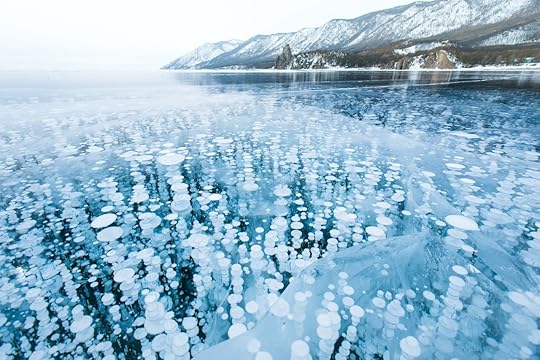
Gazing upon a body of water is scientifically proven to relieve stress. When that body of water is surrounded by the quiet and shining whiteness of winter, the scene is somehow even more serene. Some lakes may be too big to freeze while others — given their northerly locations on the planet — may freeze despite their large size. Whether turquoise waters surrounded by snowy mountain peaks in Italy or an immense frozen lake in Siberia, these are some of the world’s most beautiful lakes in winter.
1. The lakes of El Chalten, Argentina
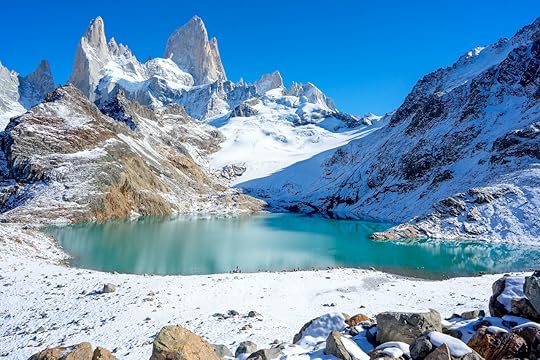
Photo: PnPy/Shutterstock
The Fitz Roy Trek on the Argentine side of Patagonia is just one of the treks that leads to the beautiful El Chalten, where milky green-blue waters tinted from the minerals in glacial runoff contrast with the peaks. The result is a scene so stunning it almost looks like a dream. Remember that winter here is summer in the Northern Hemisphere, so you have some time to get your training in for this type of grueling mid-winter hike. The reality is that hiking here in winter requires a lot of experience, but appreciating its beauty does not require much effort at all.
2. Lake Bled, Slovenia
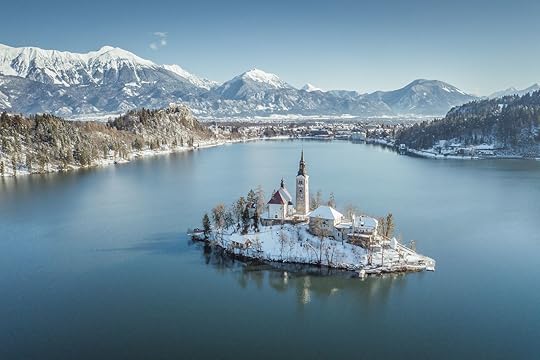
Photo: canadastock/Shutterstock
Slovenia’s Lake Bled is the most photographed lake in a country filled with beautiful lakes — and for good reason. Winter, though, offers a chance to gaze on the lake when far fewer people are present and when the white of snow adds an ethereal touch to what is already one of Europe’s most photogenic bodies of water. The spires of the Pilgrimage Church of the Assumption of Maria tower over Lake Bled in Transylvania, creating a stark contrast to the cold waters below and the Slovenian Alps in the background. The scene is at once natural and historic, conjuring the beauty of both Gothic-era architecture and the Eastern European high country.
3. Lake Louise, Alberta, Canada

Photo: BGSmith/Shutterstock
Some 3.6 million visitors travel to Banff, Canada, and Lake Louise each year. Most, however, never see this high-altitude lake in its snow-clad prime, as the vast majority of the visitors come in summer. In winter, when Lake Louise is frozen solid, gazing upon it from its center is the best way to feel as though you’re inside a snow globe. You can gaze upon it while sipping a hot toddy lakeside at the Fairmont Chateau Lake Louise, slice over it on ice skates or even while trying your hand at ice hockey, sign up for a round of Bavarian Curling on the ice, take a sleigh ride around it, or snowshoe the forested hills above.
4. Lake Baikal, Russia
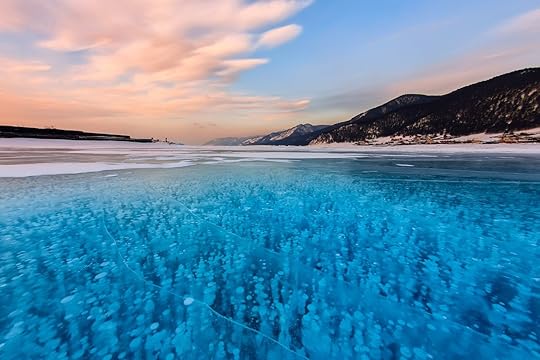
Photo: Zakirov Aleksey/Shutterstock
Russia’s Lake Baikal is already one of the most stunning lakes to ice skate on in winter, yet it also offers a beauty that few others do in winter: frozen bubbles. Methane bubbles, a result of this being a rift lake, rushing up from below are captured in time as the lake freezes. Elsewhere on Lake Baikal are caves lined with frozen stalactites, approachable from the inside when the ice has frozen solid enough.
5. Lake Laberge, Canada
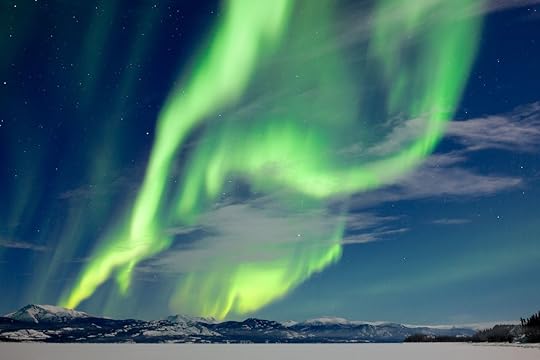
Photo: Pi-Lens/Shutterstock
No single phenomenon accentuates a frozen lake quite like the northern lights. Yukon’s Lake Laberge is proof when the green hues of the aurora borealis trail the Canadian north and reflect off its icy waters. You’ll have plenty of opportunities to see them here in winter, since in late December the sun is only above the horizon for five-plus hours a day. A check on the aurora forecast will let you know the likelihood of solar activity on any given night. When the time is right and you are at the lakeshore, all you have to do is gaze up. The colors bounce off the lake and dance in a performance that will easily take your breath away.
6. Lake Champlain, Vermont and New York
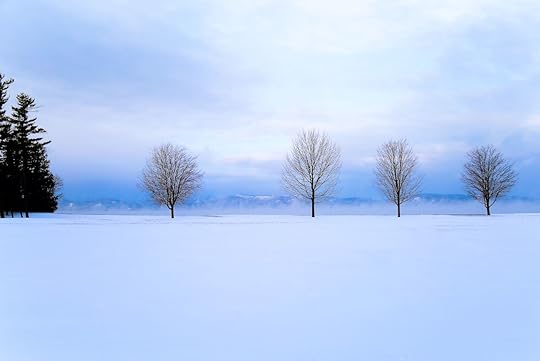
Photo: Jenny R Naylor/Shutterstock
Stroll the paved lakeside trail in downtown Burlington, Vermont, in the cold of winter and you might find yourself with a strained neck. That’s because though the trail runs north-south, you’ll spend the entire time staring west. The snow-covered hills of New York rim the horizon, while within a stone’s throw lie smooth chunks of scattered ice barely distinguishable from the wave breakers rippling toward them. After a fresh snowstorm in the dead of winter, the lake is frozen solid and covered with snow, rendering your view an endless vista of winter whiteness.
7. Lake Garda, Italy
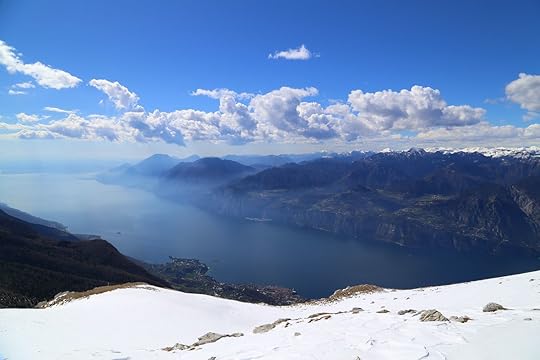
Photo: Claudiovidri/Shutterstock
In northern Italy, almost halfway between the cities of Milan and Venice lies Lake Garda, a 143-square-mile expanse surrounded by alpine peaks. A lake this big won’t freeze in winter, and the famously turquoise water keeps its vibrant hue on sunny days and turns a more steely color when it gets cloudy. You can gaze at its beauty from the hillside in the town of Bardolino, or you can view the lake and the snowline above it from Sirmione on the lake’s southern tip. Better yet, make a unique day or weekend trip out of it by driving around the lake, stopping in picturesque villages along the way for antipasti and a glass of spicy yet light red wine made with the local Bardolino varietal. On your journey, check out the humble yet beautiful Church of San Pietro in Mavino and the grand Church of Santa Maria Maggiore in Sirmione. 
More like thisParks + WildernessThe 7 most beautiful lakes to visit in winter
The post The 7 most beautiful winter lakes around the world appeared first on Matador Network.

Circular cycling path in Belgium
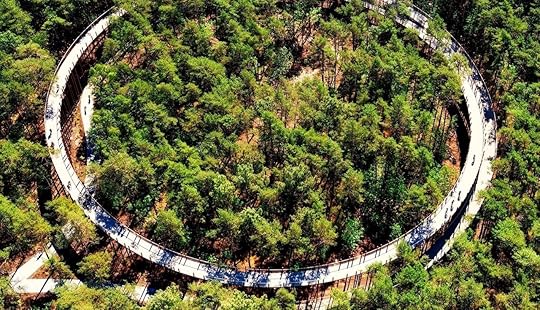
You might think that biking through a forest’s treetops entails defying the laws of physics, but it’s now possible thanks to the “Cycling through the Trees” project in Belgium.
The 2,296-foot-long track is a circular bike trail that’s eye level with the forest canopy, and the latest addition to the popular cycling network in the region of Limburg, right on the Dutch border. The steel trail rises slowly 33 feet off the ground from surrounding paths and brings cyclists level with the treetops.
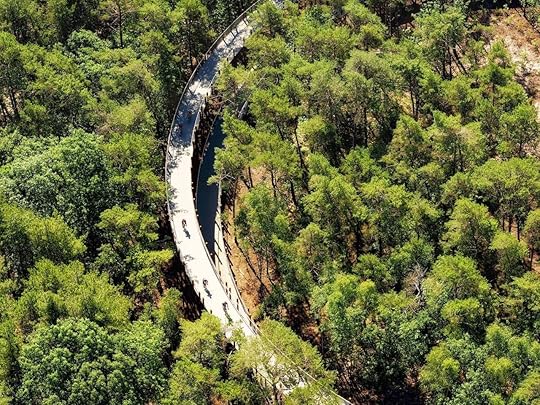
Photo: Visit Limburg/Facebook
The project was designed by Belgian studios BuroLandschap and De Gregorio & Partners with the aim of transforming Limburg into a center for cycling tourism. The intent was to encourage people to engage with the forest while also limiting any negative impact on the forest itself. This was accomplished by using a single crane to build the paths, mounted at the center of the circle, and while several trees were cut down no concrete was used (the trees felled were used to build a rest stop). The brown and orange color of the weathered steel also helps the track blend into the colors of the forest.
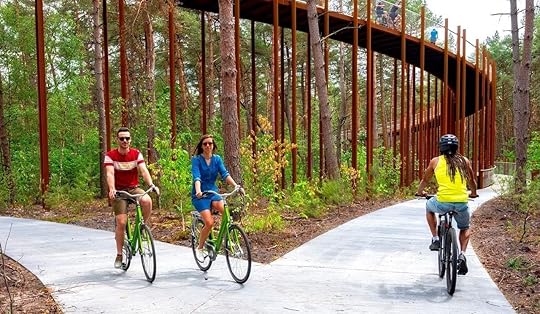
Photo: Visit Limburg
“The most important thing for us was to build a structure with the lowest possible impact on the environment and the sensitive nature present. This was the starting point! The trees were of course very important,” Pieter Daenen, founder of BuroLandschap, said. “After all, cycling through the trees would no longer make sense if trees were damaged or destroyed after the construction of the structure.”
As a testament to the project’s success, it just won an “infrastructure project of the year” award at the 2020 Dezeen Awards. 
More like thisNewsAn epic new bike trail will circle Italy’s largest lake
The post Cycle through the trees on this elevated circular bike path in Belgium appeared first on Matador Network.

Mulled wine spa treatment England
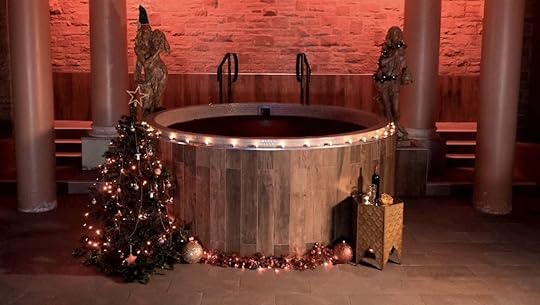
There are very few things that could make a hot tub even better than it already is, but a hot tub filled with wine is one of them.
A spa in England is creating the ultimate hot tub experience by offering a “Mulled Wine Spa,” and yes, it’s exactly what it sounds like. Guests of Shrigley Hall in Cheshire will be able to soak in a mulled wine-filled hot tub, take advantage of several mulled wine-themed treatments, and throw back a few glasses of the iconic Christmas drink while they’re at it.

Photo: SpaSeekers
The tub will be filled with traditional mulled Burgundy wine and kept at 98.6 degrees. The idea is that your pores will open, releasing toxins, and allowing your skin to absorb the tannins of the mulled wine. The wine’s ingredients, like orange, cinnamon, and star anise, supposedly provide a high level of antioxidants to make for a pretty solid detox. The spa experience also includes a 45-minute frankincense massage and a body scrub blending the aromas of brown sugar, cinnamon, and orange.

Photo: SpaSeekers
According to spa firm SpaSeekers, the wine spa can increase blood flow, improve cardiac health, boost circulation, soften your skin, and reduce inflammation — not to mention the obvious benefit of pure relaxation.
Prices for the spa start at $80 per person, and can soon be booked on the official website. 
More like thisWhere to StayThe 8 most stunning hotel hot tubs that are only a short flight away
The post The world’s first mulled wine hot tub is ready to bubble this holiday season appeared first on Matador Network.

Delta launch quarantine-free flights

One of the problems with international travel in the past few months is that it has been nearly impossible to go anywhere without quarantining for 14 days upon arrival, which isn’t feasible for most people. Now, a small step is being taken to make it more possible. Delta is launching a new transatlantic program that will eliminate quarantines on specific flights between the United States and Italy.
Designated flights will test essential passengers and crew for COVID-19. So if you’re traveling to Italy for work, health, or education, or are an EU/Italian citizen, you’ll now be able to fly to Italy from the US without quarantining.
The trial program begins on December 19 on flights between Hartsfield-Jackson Atlanta International Airport and Rome–Fiumicino International Airport. To fly, travelers must have a negative result from a PCR test taken within 72 hours prior to departure, as well as take a rapid test at the airport in Atlanta before boarding, and a second rapid test in Rome upon arrival. Those flying from Italy into the US must take a rapid test at the airport in Rome. Upon entering the US, passengers will be asked to provide contact tracing information.
Henty Ting, chief value officer at Mayo Clinic, which helped advise on this new program, said, “Based on the modeling we have conducted, when testing protocols are combined with multiple layers of protection, including mask requirements, proper social distancing and environmental cleaning, we can predict that the risk of COVID-19 infection — on a flight that is 60% full — should be nearly one in a million.” 
More like thisArt + Architecture7 underrated churches in Rome that you need to check out
The post Delta is launching quarantine-free flights between the US and Italy appeared first on Matador Network.

The world’s loneliest zoo elephant

The “world’s loneliest elephant” is on his way to a better life.
After living in poor conditions in Marghazar Zoo in Islamabad, Pakistan, since 1985, Kaavan, nicknamed the “world’s loneliest elephant,” is moving to a sanctuary in Cambodia today for a new and hopefully happier life.
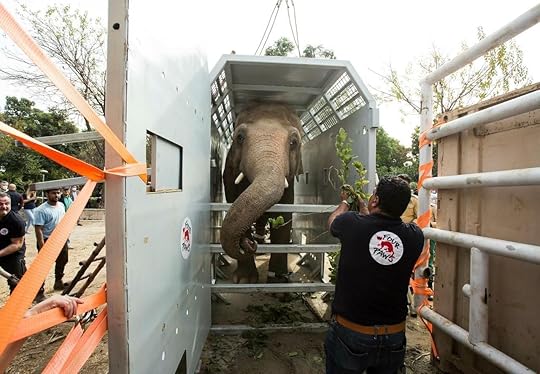
Photo: Four Paws
When he was only a year old, 35 years ago, Kaavan was gifted to Pakistan from Sri Lanka. He was kept in abysmal conditions at the Marghazar Zoo for all those years, most of which he spent in chains. Kaavan had a partner, Saheli, who lived with him from 1990 to 2012, when she died of an infection. The heartbroken elephant has been alone ever since.
Thanks to activists around the world, including singer Cher’s charity Free the Wild, Kaavan will be moved to an animal sanctuary in Siem Reap, Cambodia, today where he will finally be able to interact with other elephants. There are currently three female elephants at the sanctuary.
The quietest roads in America

If you had to choose one image to depict the essence of travel in the US, it might just be wide, open roads through wide, open landscapes. At nearly four million square miles, the country relies on its highways — in all their various iterations, some aging, two-lane relics of eras past, others traffic-jammed, billboarded behemoths — to draw its myriad regions together.
Within that intricate web of pavement lie roads gone wild, virtually abandoned, connecting little but the middle of nowhere to its edges. These are the roads where the magic of the American road trip is undeniable. Make sure you’ve got a full tank, plenty of creature comforts, and a good playlist — here’s where to hit the road.
1. Dalton Highway, Alaska
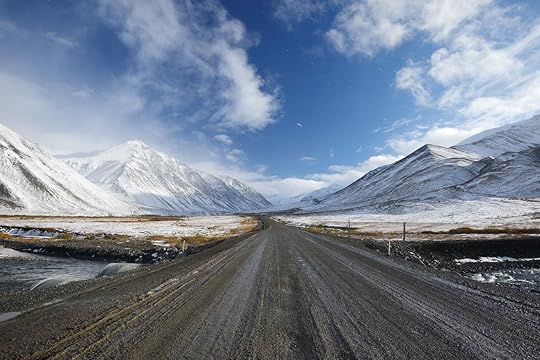
Photo: Shutterstock/saraporn
If we’re being honest, all of the country’s quietest roads are in Alaska — only 5% of the state is even paved, and it’s four times the size of California. But the path de résistance here is the Dalton Highway, a 414-mile thoroughfare from Fairbanks to Deadhorse that winds through boreal forest on gravel and dirt. A route for ice truckers and almost no one else, it skirts the eastern border of Gates of the Arctic National Park and works north past the Yukon River all the way to the Arctic Ocean.
For a true getaway from the stereotypical road trip scene — and its herds of RVs and tourists — Alaska is the place to do it. Just stock up on all your travel essentials so you can go for longer stints without resupplying, as rest stops are a less common sight here than the Northern Lights. On all of the Dalton Highway, there are three very small towns, including the world’s northernmost truck stop in Coldfoot.
2. US Route 50, Nevada
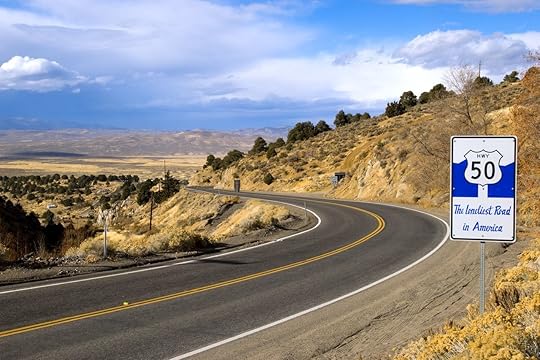
Photo: Shutterstock/Natalia Bratslavsky
Nicknamed the “Loneliest Road in America,” US Route 50 crosses the entire country from West Sacramento, California, to Ocean City, Maryland. But along the stretch through central Nevada — and Utah, if you want an add-on — its connection to the modern world flickers. Instead, it traverses forsaken mining outposts, alpine peaks, desert valleys, and the northern edge of Great Basin National Park. Here, the line between actual towns and ghost towns feels like the hands on a clock.
Start in Reno, aka the Biggest Little City, and head east — the opposite direction of gold rushers back in the 1850s. The “loneliness” sets in once you hit Fernley, ending 287 miles later in Ely. What’s in between? It’s best to go without expectations.
3. State Route 139, California
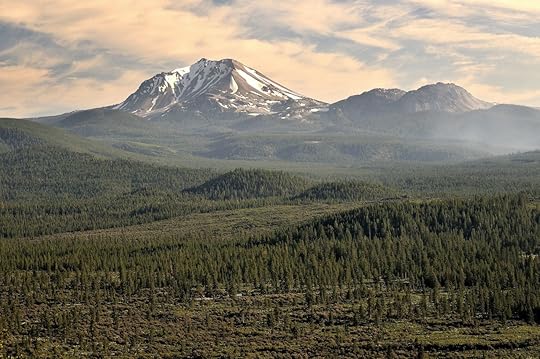
Photo: Shutterstock/Martin Froyda
It’s hard to find a quiet, untrodden spot in California, but you’d be surprised how quickly the crowds fade off the 101. Head up to Route 139 in Susanville, not too far from the state’s northeastern corner, and you have almost 140 miles of strikingly empty and starkly beautiful road stretched out in front of you — all the way to the Oregon border.
This ribbon of pavement runs just east of Lassen Volcanic National Park (Mt. Lassen remains active to this day) and takes you to Lava Beds National Monument, through Modoc National Forest, past too many lakes to mention, and — if you’d like to keep going — all the way to Klamath Falls, Oregon, just south of Crater Lake National Park.
4. US Route 45, Wisconsin and Michigan
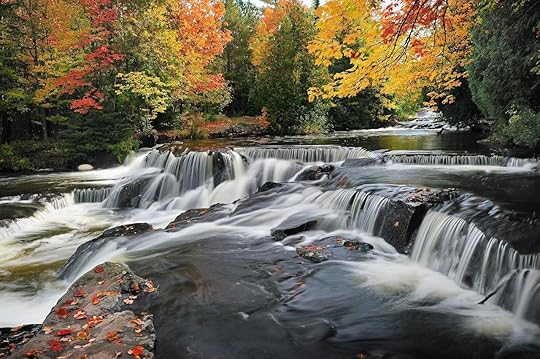
Photo: Shutterstock/John McCormick
Unlike most of the Midwest, northern Wisconsin into Michigan’s Upper Peninsula is little but Northwoods, a world of lakes, rivers, and forests that stay quiet year-round. From Pelican Lake, US Route 45 beelines straight north for Lake Superior, the map deep shades of green polka-dotted in blue (Wisconsin actually has more lakes than 10,000-famous Minnesota).
The 106-mile drive takes you to Eagle River — a great break for kayaking and tubing — across state lines at Land O’Lakes, through Ottawa National Forest, near Bond Falls and O Kun-de-kun Falls, and finally to Ontanagon, right on the shore of Lake Superior. Just to the west lies Porcupine Mountains Wilderness State Park, 60,000 acres of virgin forest you need to visit. When’s the next time you’ll be all the way up here?
5. US Route 201, Maine
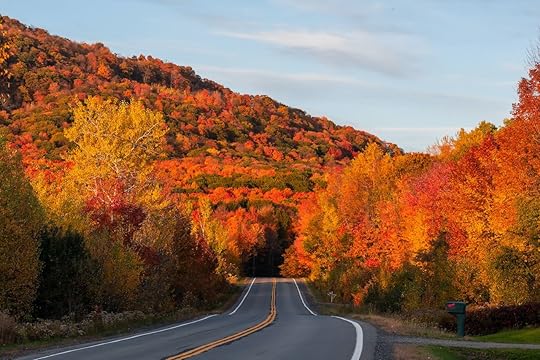
Photo: Shutterstock/Raphael Rivest
If you’re looking for an autumn leaf-peeping drive unfit for Greyhound buses and bucket-listing tourists, check out Maine’s US Route 201. The 78-mile “Old Canada Road” follows the Kennebec River through miles of forested hills painted in oranges, reds, and golds, along S-curves leading to mountain views, and into a few towns frozen in time, all the way to Quebec.
For a break from the gas pedal, go whitewater rafting at The Forks — it’s where the Kennebec and Dead Rivers meet — hike on the Kennebec Valley Trail or the Appalachian Trail, or stop for a picnic on Wyman Lake. Just remember to take it slow — that bit about the journey being the destination is certainly a cliché, but one that was born of truth on roads like these. 
The post Worth the detour: America’s loneliest, most beautiful roads appeared first on Matador Network.

Iconic dishes in San Francisco

SAN FRANCISCO is surrounded by water on three sides, so it’s no surprise that many of San Francisco’s most popular dishes come from the sea. But beyond seafood, restaurants in the City by the Bay also serve up world-famous burritos and a decadent ice cream sundae that should be at the top of everyone’s must-try list.
These are some of the most famous San Francisco foods to try when you visit, as well as the best restaurants and shops to try them at.
1. Cioppino

Photo: Tadich Grill/Facebook
Cioppino is an Italian-American dish similar to the French Mediterranean soup bouillabaisse. This seafood stew takes an everything-but-the-kitchen-sink approach with a simple recipe first created in San Francisco. It includes a medley of seafood. Depending on where you get it and when, it may include clams, mussels, Dungenous crab, squid, shrimp, or cuts of a hearty and thick fleshed fish like halibut— or all of the above, along with plenty garic, onion, and herbs. The soup base is made with white wine and tomato. Legend has it that Italian fishermen who migrated to San Francisco would pool their resources after a day’s work and throw their leftover catch into a large communal pot. Today, the dish is typically served with wine (a local chardonnay goes perfectly with the dish) and sourdough bread.
Where to find the best Cioppino in San Francisco: Tadich Grill
Tadich Grill claims to be California’s oldest continuously running restaurant, and it’s located right in the Financial District. The cioppino at Tadich Grill features a generous offering of shelled prawns, crab, mussels, clams, and local seafood served with a side of garlic bread that is perfect with the hot broth.
Address: 240 California St, San Francisco, CA 94111
2. Mission burrito

Photo: La Taqueria/Facebook
In the great burrito competition, San Francisco’s Mission burritos reign supreme. They are regularly named best in the world, and for a good reason. Flour tortillas are packed with rice, beans, meat and salsa, plus optional guacamole, sour cream, and cheese. Unlike the California burrito found in San Diego and other parts of Southern California, you won’t see any French fries in the mix in the Mission burrito. According to Bon Appetit, two places claim to have invented the Mission burrito (which is also sometimes called the San Francisco burrito or the Mission-style burrito): Taqueria La Cumbre and El Faro. Both date the creation of the Mission burrito back to the 1960s, and over-stuffed burritos have reigned in the city ever since.
Where to find the best Mission-style burrito: La Taqueria
A Mission District staple for more than 40 years, La Taqueria takes a somewhat unique approach to its burritos — owner Miguel Jara opts for no rice with his recipe. Instead, diners will find a freshly steamed flour tortilla packed with a larger serving of grilled meat, beans, salsa and other ingredients before the burrito is lightly grilled and served hot counter-side.
Address: 2889 Mission St, San Francisco, CA 94110
3. Clam chowder in a sourdough bread bowl

Photo: JJava Designs/Shutterstock
A steaming serving of chunky New England-style chowder is dished up in a bowl crafted from San Francisco’s world-famous sourdough bread for a combination that fits perfectly in the city’s foggy waterfront ambience. Clam chowder San Francisco style is different than the bowls you’ll find on the East Coast primarily because of that sourdough bread bowl. There are many places that serve the dish, and it’s easy to wonder who has the best clam chowder in San Francisco — especially if you’re looking to buy clam chowder on Fisherman’s Wharf. And while you’ll surely be satisfied with many of the bowls on offer, there’s only one that can be named best of the best.
Where to find the best Clam chowder in a sourdough bread bowl: Boudin Bistro
Boudin Bistro is located on the waterfront and has been open since 1849. The chowder at this San Francisco institution is great, but it’s the bread bowl that really makes this dish stand out. Made fresh at Boudin’s flagship bakery, the circular sourdough loaf-turned-bowl soaks up the chowder while you eat, leaving a few bites of doughy goodness as the vessel becomes part of the meal. Dip the accompanying piece of bread from the hollowed loaf to get the most out of your meal.
Address: 160 Jefferson St, San Francisco, CA 94133
4. Ghirardelli hot fudge sundae

Photo: Ghirardelli Chocolate Company/Facebook
Now known around the world for its fine chocolates, Ghirardelli (pronounced geer-ar-delly) started in San Francisco in 1852 as a confectionery shop called Ghirardely & Girard. The chocolate company that is known and loved today has a location that’s walking distance from Fisherman’s Wharf in what’s known as Ghirardelli Square on Pier 39 — one of the reasons why San Francisco is one of the most famous cities for chocolate in the world.
The Ghirardelli Ice Cream and Chocolate Shop serves sumptuous, gooey, and rich chocolate sundaes to long lines of admirers at Ghirardelli Square every day. You’ll find several variations of the ice cream delight here, all enhanced by Ghirardelli’s chocolate confections.
Where to find the best hot fudge sundae: Ghirardelli Ice Cream and Chocolate Shop
Ghirardelli’s handmade hot fudge makes all the difference with this classic recipe. Sundaes are layered with two scoops of vanilla ice cream, handmade hot fudge, diced almonds, and a cherry on top to create a sensuous pairing of hot and cold, thick and creamy.
Address: 2 New Montgomery St, San Francisco, CA 94105
5. Dungeness crab
Dungeness crab is a Pacific crab with a harvest season that starts in late-November. Demand peaks during the holiday season, but you can find it almost every day at Swan Oyster Depot. The crab gets its name from the Dungeness Spit on the Straits of Juan de Fuca, which is a strait that serves as the border between the United States and Canada. Many Dungeness are harvested locally, though it’s illegal to catch them for yourself in San Francisco Bay and San Pablo Bay.
The crabs have smaller legs than Alaskan king or snow crabs, but there’s plenty of good meat throughout the crab (especially in the body). Still, you’ll have to work for your meal, pulling meat from cracked legs and chambers within the crab’s body. The payoff is well worth the labor.
Where to find the best Dungeness crab: Swan Oyster Depot
Avoid the tourist trap crab stands at Fisherman’s Wharf and grab a spot in line at a local institution. This no-frills foodie destination always has a crowd (including regular stops by celeb chefs) waiting for a seat at the seafood bar. Once you grab a stool, go for the cracked crab and an Anchor Steam beer. Enjoy the banter as a crew of gregarious apron-clad fishmongers works its way through a non-stop procession of fresh seafood orders.
Address: 1517 Polk St, San Francisco, CA 94109 
A version of this article was previously published on July 19, 2017, and was updated on November 30, 2020, with more information.
More like thisRestaurants + BarsA guide to San Francisco’s best bars, by neighborhood
The post 5 dishes that should be on your menu in San Francisco and where to find them appeared first on Matador Network.

Family travel guide: North Carolina
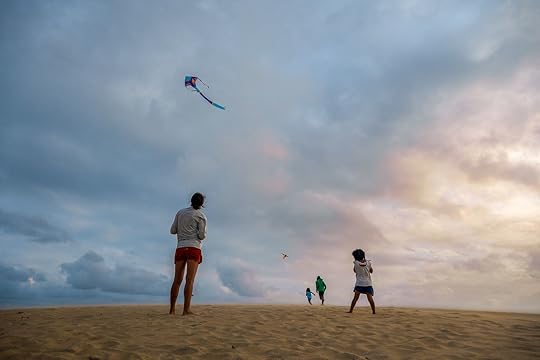
Family travel guide to the North Carolina outdoors
By: Jacqueline Kehoe
Photo: Matador Network
Some 300 years ago, Blackbeard commanded a stretch of wild waters off the coast of North Carolina. Roughly 50 years later, Daniel Boone trailblazed over the state’s hills. Fast forward another century and a half, and the Wright Brothers took flight at Kitty Hawk. Clearly, North Carolina’s greatest tales have always featured some manner of outdoor adventure — and they still do.
From the highest point east of the Mississippi River to impossibly tall sand dunes and national seashores — and the waterfalls, lakes, rivers, and forests in between — North Carolina can pack a lot into a family vacation. Add in a well-stocked Airstream, and a trip into the glorious outdoors is possible whenever, wherever.
Just remember that, while it’s clear the landscapes here are worth exploring, they’re also worth honoring and respecting. Should you visit, please visit responsibly: Pack your mask, social distance, and always Leave No Trace. The next generation deserves a North Carolina as wild and beautiful as today’s, with incredible outdoor adventures — like those you’ll find below — of their own.

This guide is proudly produced in partnership with Visit North Carolina.
Hitting new heights
Jockey's Ridge State Park
Mount Mitchell
The Appalachian Mountains used to be as high as the Himalayas, cloud-topped peaks stretching from Newfoundland to Alabama. They’ve mellowed a bit since then, but North Carolina’s Mount Mitchell still reaches for the sky. It’s the highest point in the Eastern US, hitting 6,684 feet, and from up here you might as well be king of the world.
You can drive straight to the top for a wind-blown view stretching 85 miles, or hike six miles up the mountain’s flanks to the summit (about an eight-hour round trip). Pay attention to the weather and opt for a clear day for the best family photos at the viewpoints.
For a different kind of height, head toward the coast. Jockey’s Ridge State Park, home to the tallest sand dunes on the Atlantic, is a dizzying 427-acre sandbox. Hang glide from the ridges — some dunes rise to 80 feet — walk the boardwalk, play in the sand, and definitely bring closed-toed shoes.
Note: In high season, these two spots can be pretty popular. If you’re wanting more space for you and the fam, scope out Kings Mountain, the highest point in Uwharrie National Forest. The 26-mile Uwharrie Trail connects to its summit — you can hike as little as two to reach the top — with 800 feet in elevation gain making for a solid afternoon adventure.
.map * {
font-family: sans-serif !important;
}
.info-window-link {
display: block;
margin-top: 10px;
padding: 3px 10px;
border-radius: 3px;
background-color: #0099ff;
color: white !important;
font-size: 12px;
text-align: center;
}
.info-window-link:hover {
text-decoration: none;
}
', { style: 'max-width:150px' });
$('').append(marker.title).appendTo(info);
if (marker.scroll_to) {
$('', {
class: 'info-window-link',
href: '#' marker.scroll_to,
}).append('Jump To').appendTo(info);
}
infoWindow.setContent(info[0].outerHTML);
infoWindow.open(map, target);
};
$('#' id).on('click', '.info-window-link', function(e) {
e.preventDefault();
var target = $(e.target).attr('href');
$('html, body').animate({ scrollTop: $(target).offset().top - 55 }, 1000);
});
for (var i = 0; i < markers.length; i ) {
var marker = markers[i];
if (marker.lat !== undefined && marker.lng !== undefined) {
var markerObject = {
map: map,
position: { lat: parseFloat(marker.lat), lng: parseFloat(marker.lng) },
animation: google.maps.Animation.DROP,
locationId: i,
}
if(atts.ordered !== undefined) {
markerObject.label = labels[labelIndex % labels.length];
}
if(marker.icon !== undefined) {
markerObject.icon = marker.icon;
}
var mapMarker = new google.maps.Marker(markerObject);
if (mapBounds) mapBounds.extend(mapMarker.getPosition());
if (marker.title) {
var infowindow = new google.maps.InfoWindow({ content: marker.title });
if (markers.length === 1) {
setTimeout(function() {
openInfoWindow(marker, mapMarker);
}, 1200);
}
google.maps.event.addListener(mapMarker, 'click', function() {
openInfoWindow(markers[this.locationId], this);
});
}
}
}
if (mapBounds) {
map.fitBounds(mapBounds, {top:boundPadding, right:boundPadding, left:boundPadding, bottom:boundPadding});
} else if (atts.zoom) {
map.setZoom(parseInt(atts.zoom));
} else {
map.setZoom(16);
}
});
});
Photo credits: Matador Network and Shutterstock/MarkVanDykePhotography
Getting your paddles wet
Cape Hatteras lighthouse
Pea Island National Wildlife Refuge
North Carolina provides a masterclass in ecological diversity, mountain streams transforming into ancient rivers that flow into salty marshes and bogs and — finally — the sea. You could stay here for months and be on the water every day.
In other words, deciding on a place to launch your canoe or kayak could take a while. Let’s start you off with a few ideas:
The New River — actually one of the oldest rivers in the world — is great for beginners, with gentle currents flowing alongside meadows and mountains in New River State Park. You can put in at the Kings Creek Access at river mile 7.
Paddling Pea Island National Wildlife Refuge takes you into the wide-open waters — and pelican territory — of Pamlico Sound and Cape Hatteras National Seashore.
Merchants Millpond State Park, where massive bald cypress trees, beech groves, and Spanish moss mingle between hardwood forest and swamp, has miles of paddling trails and even canoe-in campgrounds.
There’s also the Roanoke River Paddle Trail, the Tar River Paddle Trail, the Broad River Paddle Trail — and that’s not even mentioning the state’s many lakes, bays, and estuaries.
.map * {
font-family: sans-serif !important;
}
.info-window-link {
display: block;
margin-top: 10px;
padding: 3px 10px;
border-radius: 3px;
background-color: #0099ff;
color: white !important;
font-size: 12px;
text-align: center;
}
.info-window-link:hover {
text-decoration: none;
}
', { style: 'max-width:150px' });
$('').append(marker.title).appendTo(info);
if (marker.scroll_to) {
$('', {
class: 'info-window-link',
href: '#' marker.scroll_to,
}).append('Jump To').appendTo(info);
}
infoWindow.setContent(info[0].outerHTML);
infoWindow.open(map, target);
};
$('#' id).on('click', '.info-window-link', function(e) {
e.preventDefault();
var target = $(e.target).attr('href');
$('html, body').animate({ scrollTop: $(target).offset().top - 55 }, 1000);
});
for (var i = 0; i < markers.length; i ) {
var marker = markers[i];
if (marker.lat !== undefined && marker.lng !== undefined) {
var markerObject = {
map: map,
position: { lat: parseFloat(marker.lat), lng: parseFloat(marker.lng) },
animation: google.maps.Animation.DROP,
locationId: i,
}
if(atts.ordered !== undefined) {
markerObject.label = labels[labelIndex % labels.length];
}
if(marker.icon !== undefined) {
markerObject.icon = marker.icon;
}
var mapMarker = new google.maps.Marker(markerObject);
if (mapBounds) mapBounds.extend(mapMarker.getPosition());
if (marker.title) {
var infowindow = new google.maps.InfoWindow({ content: marker.title });
if (markers.length === 1) {
setTimeout(function() {
openInfoWindow(marker, mapMarker);
}, 1200);
}
google.maps.event.addListener(mapMarker, 'click', function() {
openInfoWindow(markers[this.locationId], this);
});
}
}
}
if (mapBounds) {
map.fitBounds(mapBounds, {top:boundPadding, right:boundPadding, left:boundPadding, bottom:boundPadding});
} else if (atts.zoom) {
map.setZoom(parseInt(atts.zoom));
} else {
map.setZoom(16);
}
});
});
Photo credits: Shutterstock/MarkVanDykePhotography and Shutterstock/Tom Worsley
Going on dark-sky adventures
Frisco Pier in Cape Hatteras
Cape Hatteras National Seashore
Time in the outdoors — even with littler ones — doesn’t have to start and stop with daylight. Going beyond s’mores around the campfire, North Carolina has a few ways to mix up your family’s dark-sky adventures:
Cape Hatteras National Seashore enjoys some of the darkest skies on the coast. There are four campgrounds — Oregon Inlet has heated showers and RV hook-ups — where you can set up for the night, get the fire roaring, and wait for the show.
The Mayland Earth to Sky Park in Burnsville was and is the first certified Dark Sky Park in the Southeast. It’s home to the Bare Dark Sky Observatory, tons of gardens and hiking trails, and great views from the Bob and Wanda Proffitt Viewing Terrace.
In Joyce Kilmer Memorial Forest, it’s not just the skies that light up at night. Usually occurring around the first week of June, rare blue ghost fireflies illuminate the forest in a synchronous firework display, usually lasting on and off — quick as a lightswitch — from dark to 11pm. (Hint: Bring a flashlight covered in red or blue cellophane to get around without disturbing the scene.)
Or let the fireflies simply act as inspiration. At ZipQuest in Fayetteville, nighttime ziplining whooshes you (and your headlamp) across a forest canopy and — should you choose the Waterfall Expedition — along a waterfall illuminated by the moon. Safe to say, the kids will remember this one well after you get home.
.map * {
font-family: sans-serif !important;
}
.info-window-link {
display: block;
margin-top: 10px;
padding: 3px 10px;
border-radius: 3px;
background-color: #0099ff;
color: white !important;
font-size: 12px;
text-align: center;
}
.info-window-link:hover {
text-decoration: none;
}
', { style: 'max-width:150px' });
$('').append(marker.title).appendTo(info);
if (marker.scroll_to) {
$('', {
class: 'info-window-link',
href: '#' marker.scroll_to,
}).append('Jump To').appendTo(info);
}
infoWindow.setContent(info[0].outerHTML);
infoWindow.open(map, target);
};
$('#' id).on('click', '.info-window-link', function(e) {
e.preventDefault();
var target = $(e.target).attr('href');
$('html, body').animate({ scrollTop: $(target).offset().top - 55 }, 1000);
});
for (var i = 0; i < markers.length; i ) {
var marker = markers[i];
if (marker.lat !== undefined && marker.lng !== undefined) {
var markerObject = {
map: map,
position: { lat: parseFloat(marker.lat), lng: parseFloat(marker.lng) },
animation: google.maps.Animation.DROP,
locationId: i,
}
if(atts.ordered !== undefined) {
markerObject.label = labels[labelIndex % labels.length];
}
if(marker.icon !== undefined) {
markerObject.icon = marker.icon;
}
var mapMarker = new google.maps.Marker(markerObject);
if (mapBounds) mapBounds.extend(mapMarker.getPosition());
if (marker.title) {
var infowindow = new google.maps.InfoWindow({ content: marker.title });
if (markers.length === 1) {
setTimeout(function() {
openInfoWindow(marker, mapMarker);
}, 1200);
}
google.maps.event.addListener(mapMarker, 'click', function() {
openInfoWindow(markers[this.locationId], this);
});
}
}
}
if (mapBounds) {
map.fitBounds(mapBounds, {top:boundPadding, right:boundPadding, left:boundPadding, bottom:boundPadding});
} else if (atts.zoom) {
map.setZoom(parseInt(atts.zoom));
} else {
map.setZoom(16);
}
});
});
Photo credits: Shutterstock/Mike Ver Sprill and Shutterstock/Mike Ver Sprill
Chasing the sun
Sunset from the Blue Ridge Mountains
Jordan Lake Sunrise
Mountain sunset, lake sunrise, seashore sunrise and sunset — take your pick. Golden hour makes North Carolina’s landscapes even more jaw-dropping, especially with any midday crowds long gone.
For sunset with a view, check out Waterrock Knob in Maggie Valley. This is the last hike on the Blue Ridge Parkway before Great Smoky Mountains National Park, and a quick-but-steep 0.6 miles takes you to the top for nearly 360º panoramas at 6,292 feet. (The picnic tables in the parking area — at 5,719 feet — offer great views as well.)
For early risers, there’s no better spot than Jordan Lake State Recreation Area, just west of Raleigh and south of Durham. Catch the sky turn from indigo to pink to blue, and then go for a stroll on one of the nature trails, listening for the birds’ morning chatter.
For those who can’t decide, head to Cape Lookout National Seashore, where south-facing beaches mean you get front-row views of both sunrise and sunset. You’ll have to leave the RV back on solid ground, but you’re welcome to primitive camp right on the sand, waves putting you to sleep at night and morning rays starting your day.
.map * {
font-family: sans-serif !important;
}
.info-window-link {
display: block;
margin-top: 10px;
padding: 3px 10px;
border-radius: 3px;
background-color: #0099ff;
color: white !important;
font-size: 12px;
text-align: center;
}
.info-window-link:hover {
text-decoration: none;
}
', { style: 'max-width:150px' });
$('').append(marker.title).appendTo(info);
if (marker.scroll_to) {
$('', {
class: 'info-window-link',
href: '#' marker.scroll_to,
}).append('Jump To').appendTo(info);
}
infoWindow.setContent(info[0].outerHTML);
infoWindow.open(map, target);
};
$('#' id).on('click', '.info-window-link', function(e) {
e.preventDefault();
var target = $(e.target).attr('href');
$('html, body').animate({ scrollTop: $(target).offset().top - 55 }, 1000);
});
for (var i = 0; i < markers.length; i ) {
var marker = markers[i];
if (marker.lat !== undefined && marker.lng !== undefined) {
var markerObject = {
map: map,
position: { lat: parseFloat(marker.lat), lng: parseFloat(marker.lng) },
animation: google.maps.Animation.DROP,
locationId: i,
}
if(atts.ordered !== undefined) {
markerObject.label = labels[labelIndex % labels.length];
}
if(marker.icon !== undefined) {
markerObject.icon = marker.icon;
}
var mapMarker = new google.maps.Marker(markerObject);
if (mapBounds) mapBounds.extend(mapMarker.getPosition());
if (marker.title) {
var infowindow = new google.maps.InfoWindow({ content: marker.title });
if (markers.length === 1) {
setTimeout(function() {
openInfoWindow(marker, mapMarker);
}, 1200);
}
google.maps.event.addListener(mapMarker, 'click', function() {
openInfoWindow(markers[this.locationId], this);
});
}
}
}
if (mapBounds) {
map.fitBounds(mapBounds, {top:boundPadding, right:boundPadding, left:boundPadding, bottom:boundPadding});
} else if (atts.zoom) {
map.setZoom(parseInt(atts.zoom));
} else {
map.setZoom(16);
}
});
});
Photo credits: Shutterstock/TheBigMK and Shutterstock/Joe Prendergast
Enjoying (a different kind of) camping
Schoolhouse Falls in Nantahala National Forest
Forest trail in Fires Creek
Life in the time of COVID-19 means the allure of packed campgrounds at state parks and RV resorts has dulled a little. You want to get outdoors and away from everything — and stuck between a herd of RVs certainly isn’t that. Enter North Carolina’s more innovative campgrounds:
The “riverside platforms” of Roanoke River are an undersell: They’re literal platforms elevated directly above the water, with privies, fire pits, and, in a few cases, screens. You’ll just have to kayak or canoe to get there.
Deep in Nantahala National Forest, you’ll find Fires Creek Recreation Area, a remote, backcountry experience great for fishing, picnicking, hiking, and camping. The 25-mile Rim Trail traverses this section of the forest, and the campground sits near the base of Leatherwood Falls.
It takes some effort to get there (via boat or ferry), but considering Portsmouth Island feels like a trip back in time, that’s understandable. There’s almost zero development, but even RV campers are welcome to set up shop on the island’s 13 miles of beaches and dunes, right next to the water.
Note: It’s doubly important when you’re somewhere truly wild to leave no trace. Always pack in what you pack out, and leave any campsite the way you found it.
.map * {
font-family: sans-serif !important;
}
.info-window-link {
display: block;
margin-top: 10px;
padding: 3px 10px;
border-radius: 3px;
background-color: #0099ff;
color: white !important;
font-size: 12px;
text-align: center;
}
.info-window-link:hover {
text-decoration: none;
}
', { style: 'max-width:150px' });
$('').append(marker.title).appendTo(info);
if (marker.scroll_to) {
$('', {
class: 'info-window-link',
href: '#' marker.scroll_to,
}).append('Jump To').appendTo(info);
}
infoWindow.setContent(info[0].outerHTML);
infoWindow.open(map, target);
};
$('#' id).on('click', '.info-window-link', function(e) {
e.preventDefault();
var target = $(e.target).attr('href');
$('html, body').animate({ scrollTop: $(target).offset().top - 55 }, 1000);
});
for (var i = 0; i < markers.length; i ) {
var marker = markers[i];
if (marker.lat !== undefined && marker.lng !== undefined) {
var markerObject = {
map: map,
position: { lat: parseFloat(marker.lat), lng: parseFloat(marker.lng) },
animation: google.maps.Animation.DROP,
locationId: i,
}
if(atts.ordered !== undefined) {
markerObject.label = labels[labelIndex % labels.length];
}
if(marker.icon !== undefined) {
markerObject.icon = marker.icon;
}
var mapMarker = new google.maps.Marker(markerObject);
if (mapBounds) mapBounds.extend(mapMarker.getPosition());
if (marker.title) {
var infowindow = new google.maps.InfoWindow({ content: marker.title });
if (markers.length === 1) {
setTimeout(function() {
openInfoWindow(marker, mapMarker);
}, 1200);
}
google.maps.event.addListener(mapMarker, 'click', function() {
openInfoWindow(markers[this.locationId], this);
});
}
}
}
if (mapBounds) {
map.fitBounds(mapBounds, {top:boundPadding, right:boundPadding, left:boundPadding, bottom:boundPadding});
} else if (atts.zoom) {
map.setZoom(parseInt(atts.zoom));
} else {
map.setZoom(16);
}
});
});
Photo credits: Visit North Carolina and Shutterstock/milepost430media
Taking to two wheels
Mountain biking in West North Carolina
Blue Ridge Parkway
It’s difficult to get stuck in a crowd when you’re zooming away on two wheels. From mountains to beaches, from kid-friendly, paved rail trails to rugged treks through the forest, North Carolina is neither wanting for scenery nor trail diversity. Here are a few ideas:
Fonta Flora State Trail — which will eventually connect Morganton to Asheville — zooms through Lake James State Park, a section of Pisgah National Forest, and Fonta Flora County Park. It also provides access to the Mountains-to-Sea State Trail.
Over 22 miles of old railroad tracks have been converted into the American Tobacco Trail, through and out of Durham. It’s a healthy mixture of city scenes, rural vistas, and dense pine forests.
Rent beach cruisers for the kids and take to the sand at Ocean Isle Beach, near the state’s southern border. Consider it a lower-key Myrtle Beach, with far fewer crowds.
.map * {
font-family: sans-serif !important;
}
.info-window-link {
display: block;
margin-top: 10px;
padding: 3px 10px;
border-radius: 3px;
background-color: #0099ff;
color: white !important;
font-size: 12px;
text-align: center;
}
.info-window-link:hover {
text-decoration: none;
}
', { style: 'max-width:150px' });
$('').append(marker.title).appendTo(info);
if (marker.scroll_to) {
$('', {
class: 'info-window-link',
href: '#' marker.scroll_to,
}).append('Jump To').appendTo(info);
}
infoWindow.setContent(info[0].outerHTML);
infoWindow.open(map, target);
};
$('#' id).on('click', '.info-window-link', function(e) {
e.preventDefault();
var target = $(e.target).attr('href');
$('html, body').animate({ scrollTop: $(target).offset().top - 55 }, 1000);
});
for (var i = 0; i < markers.length; i ) {
var marker = markers[i];
if (marker.lat !== undefined && marker.lng !== undefined) {
var markerObject = {
map: map,
position: { lat: parseFloat(marker.lat), lng: parseFloat(marker.lng) },
animation: google.maps.Animation.DROP,
locationId: i,
}
if(atts.ordered !== undefined) {
markerObject.label = labels[labelIndex % labels.length];
}
if(marker.icon !== undefined) {
markerObject.icon = marker.icon;
}
var mapMarker = new google.maps.Marker(markerObject);
if (mapBounds) mapBounds.extend(mapMarker.getPosition());
if (marker.title) {
var infowindow = new google.maps.InfoWindow({ content: marker.title });
if (markers.length === 1) {
setTimeout(function() {
openInfoWindow(marker, mapMarker);
}, 1200);
}
google.maps.event.addListener(mapMarker, 'click', function() {
openInfoWindow(markers[this.locationId], this);
});
}
}
}
if (mapBounds) {
map.fitBounds(mapBounds, {top:boundPadding, right:boundPadding, left:boundPadding, bottom:boundPadding});
} else if (atts.zoom) {
map.setZoom(parseInt(atts.zoom));
} else {
map.setZoom(16);
}
});
});
Photo credits: Matador Network and Shutterstock/Gingo Scott
Saying hello to the wildlife (from a safe distance)
Wild horses of Corolla
Black bear cubs in the Smoky Mountains
In Great Smoky Mountains National Park, there are — on average — two black bears per square mile. If you’re lucky, you might also spot otters, elk, falcons, and woodchucks, amongst hundreds of other species.
Then, of course, there are the famous wild horses of Corolla. You could drive up NC-12 until the road ends to spot the majestic creatures (and then continue onto the sand if you have 4WD), but a more rewarding option is to take a 4×4 jeep tour and go with the pros.
Meanwhile, at Alligator River National Wildlife Refuge, no, you probably won’t spot an alligator. But you might catch a glimpse of black bears, white-tailed deer, red wolves, and — if your eyes are peeled — several species of marsh birds.
But anywhere you go, any hike you take, any park you visit, you’re in some pretty wild company. Just be sure to keep a healthy distance, and never disturb the animals. They’re sharing the tremendous landscapes of North Carolina with you — pay them back with a dose of respectful gratitude.
.map * {
font-family: sans-serif !important;
}
.info-window-link {
display: block;
margin-top: 10px;
padding: 3px 10px;
border-radius: 3px;
background-color: #0099ff;
color: white !important;
font-size: 12px;
text-align: center;
}
.info-window-link:hover {
text-decoration: none;
}
', { style: 'max-width:150px' });
$('').append(marker.title).appendTo(info);
if (marker.scroll_to) {
$('', {
class: 'info-window-link',
href: '#' marker.scroll_to,
}).append('Jump To').appendTo(info);
}
infoWindow.setContent(info[0].outerHTML);
infoWindow.open(map, target);
};
$('#' id).on('click', '.info-window-link', function(e) {
e.preventDefault();
var target = $(e.target).attr('href');
$('html, body').animate({ scrollTop: $(target).offset().top - 55 }, 1000);
});
for (var i = 0; i < markers.length; i ) {
var marker = markers[i];
if (marker.lat !== undefined && marker.lng !== undefined) {
var markerObject = {
map: map,
position: { lat: parseFloat(marker.lat), lng: parseFloat(marker.lng) },
animation: google.maps.Animation.DROP,
locationId: i,
}
if(atts.ordered !== undefined) {
markerObject.label = labels[labelIndex % labels.length];
}
if(marker.icon !== undefined) {
markerObject.icon = marker.icon;
}
var mapMarker = new google.maps.Marker(markerObject);
if (mapBounds) mapBounds.extend(mapMarker.getPosition());
if (marker.title) {
var infowindow = new google.maps.InfoWindow({ content: marker.title });
if (markers.length === 1) {
setTimeout(function() {
openInfoWindow(marker, mapMarker);
}, 1200);
}
google.maps.event.addListener(mapMarker, 'click', function() {
openInfoWindow(markers[this.locationId], this);
});
}
}
}
if (mapBounds) {
map.fitBounds(mapBounds, {top:boundPadding, right:boundPadding, left:boundPadding, bottom:boundPadding});
} else if (atts.zoom) {
map.setZoom(parseInt(atts.zoom));
} else {
map.setZoom(16);
}
});
});
Photo credits: Shutterstock/glenda and Shutterstock/jadimages

This guide is proudly produced in partnership with Visit North Carolina.
The post Family travel guide to the North Carolina outdoors appeared first on Matador Network.

November 25, 2020
Costa Rica is giving away free trips
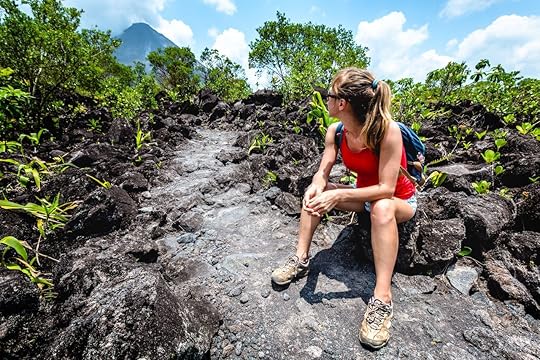
Hopefully travel will make a triumphant comeback in 2021, and we can stop longing for those faraway destinations we’ve had to put on the back burner. Costa Rica is already looking forward to the new year, with a campaign designed to encourage travel to Costa Rica. Visit Costa Rica, the country’s tourism agency, is asking people to nominate someone who has made a meaningful difference in their lives to win a free trip to Costa Rica.
The “Who is Essential to You” campaign is accepting nominations from all across the US. Fifteen winners will be selected and awarded a trip for two to Costa Rica for seven days. The prize includes roundtrip coach airfare to Costa Rica, six nights in hotel accommodations, a $200 meal voucher, ground transportation, and travel insurance (including COVID-19 coverage).
Nominations are being accepted starting November 26, 2020, through January 31, 2021, at 11:59 PM EST. The best part is you have over a year to take the trip; all trips must be taken by February 28, 2022. More information about nominations will be available online once the contest goes live on November 26, but you should be prepared to share a story about why the nominee deserves a trip to Costa Rica and what impact they’ve had on your life.
More contest rules and details can be found on the campaign’s official contest page. 
More like thisNewsCosta Rica is dropping its COVID-19 test requirement
The post Costa Rica is giving away 15 free trips in 2021, and you can nominate your loved ones appeared first on Matador Network.

Matador Network's Blog
- Matador Network's profile
- 6 followers



